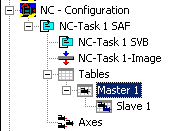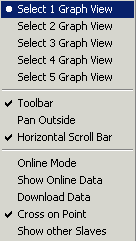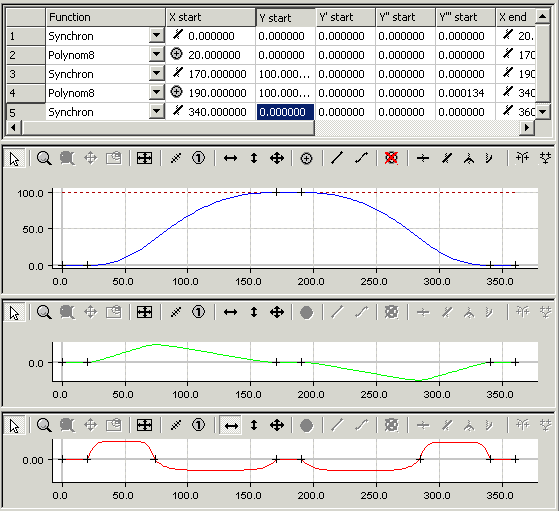Example 6
The procedure for creating a motion diagram is illustrated in this simple example.
The task:
The following slave motion is to be implemented for a rotation of the master axes from 0 to 360 degrees.
- A rest (stationary slave axis) between 0 and 20 degrees
- A rest between 170 degrees and 190 degrees at slave position 100 mm
- A rest (stationary slave axis) between 340 and 360 degrees
- The other motion sections are to join those with a 8th oder polynomial.
In a new configuration of the System Manager, we use a right mouse click under NC Configuration to insert a new task under a Append Task. In the Tables that it contains, we right click with the mouse to create a new master using Append Table, and also to create a slave under Append Slave.

When Slave 1 has been selected in the tree, both the Graphic and Table Window appear.
The Insert Point command is used in the graphic window to click the points at their approximate positions in the window. The corresponding values will then be inserted into the table window.
A certain amount of information must be added so that this motion plan can become a motion diagram. For the first, third and fifth sections we use the Synchronous Function command to specify by clicking with the mouse in the corresponding sections that a linear motion should take place there. In the second and fourth sections in the table of Function the Polynomial 8 is selected.
The position of the points can now be manipulated using the shifting commands.
If Select 3 Graph View is selected with a right mouse click, then in addition to the position of the slave in the first graphic window, the velocity is shown in a second window and the acceleration in a third.

The size of the windows can be altered interactively, by placing the mouse on the edge and dragging it with the left mouse button.
So that the positions can be reached exactly, they are entered in the table view.

In the graphics of the acceleration there is a cross at zero crossing. This point can be moved horizontaly. This modifies the symmetry value and the positive and negative acceleration.
This possibility exists only for the rest in rest motion functions (Polynom3, Polynom5, Polynom8, Sinusline, ModSinusline, Bestehorn, AccTrapezoid).